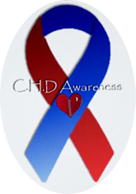About 35,000 infants (1 out of every 125) are born with heart defects in the United States each year. The defect may be so slight that the baby appears healthy for many years after birth, or so severe that his/her life is in immediate danger.
It is the #1 Birth Defect in babies born in the United States.
40,000 families this year in the US will become parents of a baby with CHD.
It is the #1 Birth Defect in babies born in the United States.
40,000 families this year in the US will become parents of a baby with CHD.
Heart defects are among the most common birth defects and are the leading cause of birth defect related deaths. However, advances in diagnosis and surgical treatment have led to dramatic increases in survival for children with serious heart defects. In the US, about 1.4 million children and adults live with congenital heart defects today. Almost all are able to lead active, productive lives.
What is a Congenital Heart Defect?
A congenital heart defect is an abnormality in any part of the heart that is present at birth. Heart defects originate in the early weeks of pregnancy when the heart is forming.
How do heart defects affect a child?
Some babies and children with heart defects experience no symptoms. The heart defect may be diagnosed if the health care provider hears an abnormal sound, called a murmur. Children with normal hearts also can have heart murmurs, called innocent or functional murmurs.
Certain heart defects can cause congestive heart failure.
In this condition, the heart can't pump adequate blood to the lungs or other parts of the body. It can lead to fluid build-up in the heart, lungs and other parts of the body. An affected child may experience a rapid heartbeat and breathing difficulties, especially during exercise. Infants may experience these difficulties during feeding, sometimes result in in poor weight gain. Affected infants and children also may have swelling of the legs or abdomen or around the eyes.
Some heart defects result in a pale grayish or bluish coloring of the skin called cyanosis. This usually appears soon after birth or during infancy and should be evaluated immediately by a health care provider. On occasion, cyanosis may be delayed until later in childhood. Cyanosis is a sign of defects tha tprevent the blood from getting enough oxygen. Children with cyanosis may tire easily. Symptoms, such as shortness of breath and fainting, often worsen when the child exerts himself. Some youngsters may squat frequently to ease their shortness of breath.
What causes congenital heart defects?
In most cases, scientists do not know what makes a baby's heart develop abnormally. Genetic and environmental factors appear to play roles.






















